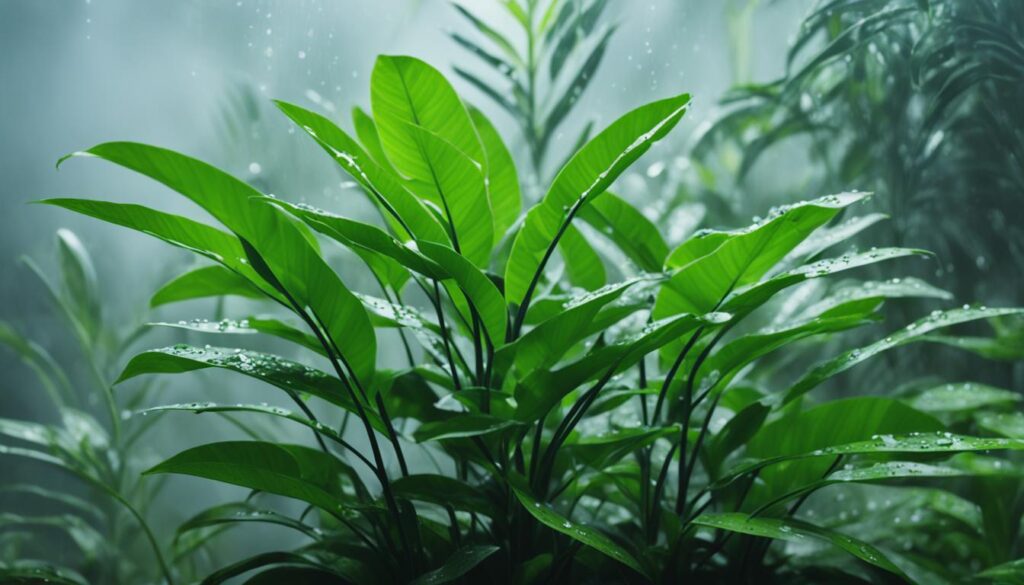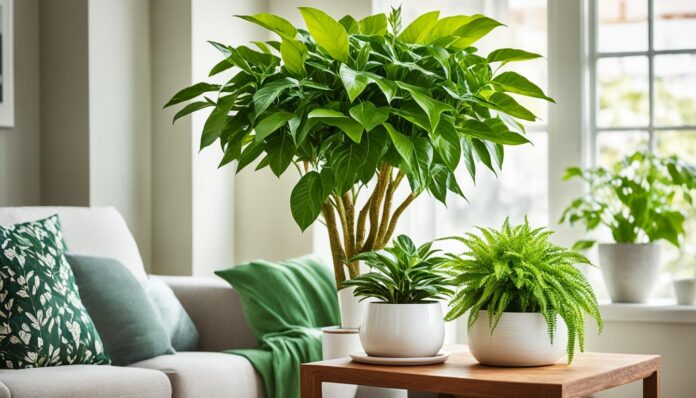The Philodendron Billietiae, also known as the Billie Plant, is a tropical houseplant that can add beauty and greenery to any indoor space. With its large, heart-shaped leaves and relatively easy care requirements, the Billie Plant has become a favorite among plant enthusiasts. Whether you’re a beginner or an experienced plant parent, this article will provide you with essential tips to help your Billie Plant thrive and contribute to a vibrant, indoor oasis.
Key Takeaways:
- Provide bright but indirect light for your Billie Plant to thrive.
- Maintain temperatures between 65 and 80 degrees Fahrenheit for optimal growth.
- Keep the humidity levels high to create a suitable environment for the plant.
- Ensure well-draining soil to prevent root rot and promote healthy growth.
- Fertilize once a month and prune dead leaves for optimal Billie Plant care.
Growth and Size of the Billie Plant
The Philodendron Billietiae, also known as the Billie Plant, has impressive growth potential both in its natural habitat and as a houseplant. In the wild, this tropical plant can reach towering heights and feature leaves that span up to three feet in length. However, when grown in a pot indoors, the Billie Plant typically attains a more manageable size, reaching a height of around three feet and a width of approximately eight inches.
While the Billie Plant’s size may not match its wild counterparts, it still warrants careful consideration in terms of its growth requirements. To support its vertical growth and prevent drooping, the plant may need the assistance of a stake or trellis. This will help maintain its elegant appearance and prevent any potential damage or stress caused by the weight of its foliage.
As the Billie Plant grows over time, repotting becomes necessary to accommodate its increasing size and provide fresh nutrients. Ideally, repotting should occur every two years, allowing the plant’s roots to expand into a slightly larger pot. This ensures sufficient space for growth while avoiding root compaction that can hinder the plant’s development.
Proper pot size selection plays an essential role in providing an optimal environment for the Billie Plant’s growth. It is crucial to choose a pot that is only slightly larger than its current one to strike a balance between accommodating growth and preventing overly large containers that can retain too much moisture. This careful consideration promotes healthy root development and minimizes the risk of root rot.
Ideal Pot Sizes for Different Stages of Billie Plant Growth
| Growth Stage | Ideal Pot Size |
|---|---|
| Young Plant (up to 1 year) | 6-8 inches |
| Maturing Plant (1-3 years) | 8-10 inches |
| Established Plant (3+ years) | 10-12 inches |
The table above provides a general guideline for pot sizes based on the Billie Plant’s growth stages. It is advisable to closely monitor the plant’s overall size and root development to determine the most suitable pot size during repotting.
By understanding the growth and size requirements of the Billie Plant, you can ensure that it thrives in its indoor environment, providing a captivating presence with its lush foliage.
Light and Temperature Requirements for the Billie Plant
The Billie Plant, also known as Philodendron Billietiae, requires specific light and temperature conditions to thrive as an indoor plant. Creating an environment that closely mimics its natural habitat is essential for its optimal growth and health.
Light Requirements
The Billie Plant flourishes in bright but indirect light. Direct sunlight can be too intense and can result in leaf scorching. For best results, place the plant near a north or east-facing window where it can receive filtered light or dappled sunlight throughout the day. This will help replicate the conditions it would experience in its native tropical regions.
If a suitable window is not available, artificial grow lights can be used as an alternative. LED or fluorescent lights with a wide spectrum range are ideal for providing the necessary light intensity and color temperature.
Temperature Range
Maintaining the right temperature range is crucial for the well-being of the Billie Plant. During the day, temperatures between 65 and 80 degrees Fahrenheit (18-27 degrees Celsius) are ideal. This range allows the plant to thrive and promotes healthy growth.
At night, the Billie Plant prefers slightly cooler temperatures between 55 and 65 degrees Fahrenheit (13-18 degrees Celsius). Avoid exposing the plant to extreme temperature fluctuations or drafts, as this can stress the plant and impact its overall health.
Providing the right light and temperature conditions will ensure that your Billie Plant remains vibrant and thrives as an indoor plant. Taking the time to create an ideal environment for your plant will result in lush foliage and a beautiful addition to your home or office space.
Humidity, Soil, and Watering for the Billie Plant

The Billie Plant, also known as the Philodendron Billietiae, is a tropical houseplant that thrives in high humidity. To create a humid environment for your Billie Plant, you can regularly mist the leaves using a spray bottle. Another method is placing the plant on a tray filled with pebbles and water. The evaporating water will help increase the humidity around the plant.
When it comes to watering the Billie Plant, it’s important to strike the right balance. The top inch of soil should be allowed to dry out between waterings. This prevents overwatering and ensures the roots stay healthy. To check if it’s time to water, simply stick your finger into the soil. If it feels dry to the touch, it’s time to water.
For optimal growth, the Billie Plant requires well-draining soil. A mixture of perlite, compost, and sphagnum peat moss is recommended to maintain proper drainage. Avoid using heavy potting soil as it can smother the roots and promote fungal growth.
Fertilizing, Pruning, and Propagation of the Billie Plant
To keep your Billie Plant healthy and thriving, it is essential to provide proper care, including fertilizing, pruning, and propagation methods. Fertilizing the plant every few months with a slow-release fertilizer containing potassium, nitrogen, and phosphorus will supply the necessary nutrients for optimal growth.
When it comes to pruning, it is recommended to use sterilized cutting tools to remove any dead or damaged leaves. This not only improves the plant’s appearance but also promotes healthy growth. Regular pruning also helps the Billie Plant maintain its shape and size.
Propagation of the Billie Plant can be done through stem cuttings. During the plant’s growth period, carefully select a healthy stem and cut it just below a node. Place the cuttings in water or a well-draining soil mix, ensuring that at least one node is submerged. Keep the cuttings in a warm and humid environment until new growth emerges, indicating successful propagation.
While caring for your Billie Plant, it is important to be aware of common pests, such as aphids and mealybugs. Regularly inspect the plant for any signs of infestation, and take appropriate measures to eradicate these pests. Additionally, keeping an eye out for symptoms of root rot and fungus is crucial. Overwatering and poor soil drainage can lead to these issues, so it is essential to strike a balance with watering and use a well-draining soil mix.
FAQ
How tall does the Billie Plant grow?
In its natural habitat, the Philodendron Billietiae can grow extremely tall and have leaves up to three feet long. However, as a houseplant, it usually reaches a height of around three feet and a width of about eight inches when planted in a pot.
What kind of light does the Billie Plant need?
The Billie Plant requires bright but indirect light to mimic its wild habitat. Direct sunlight can scorch the leaves, so it is best to place it near a north or east-facing window, or provide filtered light.
How often should I water the Billie Plant?
The Billie Plant should be watered when the top inch of soil feels dry to the touch, allowing it to dry out completely between waterings to avoid overwatering.
How do I propagate the Billie Plant?
Propagation can be done by taking stem cuttings during the plant’s growth period and rooting them in water or soil. Once rooted, the cuttings can be planted in a well-draining soil mix and kept in a warm environment until new growth appears.
What pests should I watch out for when caring for the Billie Plant?
Common pests for the Billie Plant include aphids and mealybugs. It is important to regularly inspect the plant for any signs of infestation and take appropriate measures to eliminate the pests.

